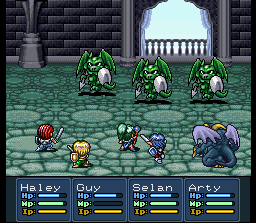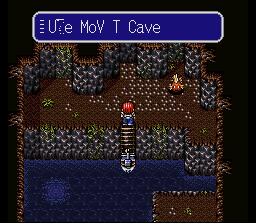 ... ...
Although many have said that Lufia 2 is leaps and bounds above its predecessor, I ended up liking it somewhat less. The original SNES Lufia game is not one of my favorite RPGs by far, but I still have a fondness for it. It had a quick pace, fun battle system, and very entertaining dialogue. With just that much going for it, I had hoped that a sequel could take that, improve everything else, and elevate the series to a new height. Lufia 2 succeeds in some ways, but it doesn't excel beyond a certain level and ends up repeating much of what was already done in Lufia 1. Only this time around, it's not as entertaining and I'm not as forgiving.
GRAPHICS: 7.5/10
The first overwhelming difference between Lufia 2 and Lufia 1 is that the graphics have improved drastically. Now, when you get into battles with enemies, you are sent to a separate view with full backgrounds. Areas are much more detailed and the choice of colors, especially in the case of the towns, is no longer nauseating. I'd hesitate a guess that the biggest influence on Lufia 2's new look was Final Fantasy 6, as the towns have a similar style, and the overworld utilizes Mode 7.
Despite the addition of a few mountain areas to explore, most of this game's dungeons still amount to "cave" and "tower" (and shrines, which are very similar to the towers.) These places look so much alike that it's beyond me to remember one from another without a scorecard. Character sprites, which have that super-deformed anime style, are an improvement over Lufia 1, but they still have the same stunted battle and walking animations. Enemies look much better, even if they aren't very fearsome. But, hey, at least Lufia 2 now has a realistic coastline!
 ... ...
SOUND:
8/10
Lufia 2's music is arguably better than Lufia 1's, but it's still not quite among the greatest game soundtracks I've heard. Gone is the somewhat-awkward Ys-style approach, which is replaced with a more traditional-sounding symphonic RPG suite. What's odd is that the music often portrays a sense of emotion that should be present, but really isn't. If its boss theme isn't the best boss theme I've ever heard in an RPG then it comes damn near close. It's certainly something that makes you think of a life-or-death situation; too bad there aren't any challenging bosses in the game worthy of it. My second-favorite song is the thundering castle theme, which echoes a noble sentiment that I only wish the game's story had complied with. Other music is standard RPG brass and drums fare, with a few songs recycled from Lufia 1 (such as the excellent Fortress of Doom theme.) The ending theme played over the closing credits is outstanding. At least you get one good reward for finishing this game.
 ... ...
STORY/ATMOSPHERE:
5/10
My real disappointment in Lufia 2 began with its story. As a prequel, it centers on the events leading up to what occurred in the beginning sequence of Lufia 1. If you've played that game, then you've already had much of Lufia 2's ending spoiled for you. That's not necessarily a reason to not play it, though. I'm more concerned with the fact that very little of what goes on in Lufia 2 has anything to do with the main plot. As the game opens up we are introduced to the Sinistrals, a race of super-beings who believe it is their right to destroy humanity and rule the world. We are shown a new character, Arek, who was not present in Lufia 1 and appears to be the true ruler of the Sinistrals. But never mind him, because he's totally forgotten by the end of the game. Maxim, a young monster hunter, hears of a mysterious ball of red light that has plunged into the sea, and he sets off to investigate it. On his way, he meets a strange woman with great magical powers named Iris who tells him it is his destiny to confront and defeat the Sinistrals. And from there on out, it's one random event after another, each of which has little or nothing to do with anything that happens before it or after it. The focus only returns to the main plot when you run out of places on the map to visit.
Lufia 2 tries way too hard to explain things in Lufia 1. I really didn't need history lessons on the Hope Ruby and the Priphea (Lufia's favorite flower). These were minor plot devices in Lufia 1, and the only effect caused by having them in Lufia 2 is to make you feel like you're playing the same game twice. The worst part is that none of these elements are introduced in a way that makes them relevant to Maxim's quest. What, praytell, does a giant catfish causing earthquakes (*cough* Zelda 3 *cough*), a woman who needs a flower from a mountain, a king's crown being stolen by two thieves who are a very lame attempt at funny cartoon-style villains, and a feud between two backwater kingdoms over a stolen artifact have to do with anything? There is a scene near the end of the game where the dialogue tries to make me feel "guilty" about three women who volunteer to sacrifice themselves for your cause. But I can't feel guilty because I have never met nor heard anything about them up until this point. They are just items with a purpose to be used. Even elements that try to focus attention back to the story end up being too similar to Lufia 1. Who would've guessed that Professor Shaia would give you a boat that eventually turns into a submarine, and then an airship, or that the Dual Blade, the one sword capable of defeating the Sinistrals, would be found in an underwater shrine? Anyone who's played Lufia 1, because those exact same things happened!
There is even has a "false ending" in which you are reduced to the role of "spectator" as a bunch of flirtatious scenes involving Maxim and Selan ensue. This was meant not only to endear us to their sudden relationship, but to also make us forget the rather cold way that Maxim's first love interest had just been ejected from the plot. Maybe they should've had a man with a sword fall on top of her, instead.
Lufia 2 does have one bright spot, and that is the character Dekar. He is a ridiculous-looking knight who provides much comic relief due to his overcofidence and lack of intelligence. Some of his scenes are genuinely funny (unlike many other attempts at humor in this game), such as one instance in which he forgets how to open a dungeon room door. It's a shame he's only there for a brief time. Dekar should've been saved for a different game, one with an actual attention span.
CHALLENGE:
5/10
RPGs generally aren't the most challenging genre of games, and I certainly don't play them expecting to be tested like I am when I play Level 6 of Ninja Gaiden. But Lufia 2 is almost inexcusably easy. I only lost to one boss near the beginning, mostly out of my own carelessness, and never once felt in danger when fighting any of the others. Do I level up too much? I don't think so, considering that enemies are not random inside of dungeons, and there are usually only 1-3 per room. Even if I fought every enemy I see, I'm still not fighting as much as I would in an RPG with random battles.
So I guess that's what the puzzles are for. Those annoying puzzles. Now, I am the kind of gamer who likes to have puzzles in adventure games and RPGs, but I'm not quite sure Lufia 2's are what I had in mind. Many of them involve matching floor tiles so they all turn a certain color or placing bombs in a distinct pattern to blow up grass patches. These puzzles are very reminiscent of those old sliding number puzzle games I had when I was a kid (there is a video game version of one in the NES Final Fantasy.) And I'll tell you now that I hated those things. I'd often "solve" them by taking them apart and snapping the pieces back together in the right order. Lufia 2 doesn't afford me that same luxury. When I first played Lufia 2, I solved every single one of these puzzles on my own including, yes, the optional "World's Most Difficult Trick", which, not surprisingly, I didn't find as difficult as some of the non-optional stuff. I can't express the frustration I felt when it took me over an hour to solve a floor tile problem, only to enter the next room and find another floor tile puzzle which took me another hour or so to solve, only to enter the next room and find ANOTHER one! My patience and motivation wore thin at times considering the plot almost never offered any reward for completing these tasks. (Granted, I would like to mention that if you do like those kinds of puzzles, then Lufia 2 shouldn't disappoint you, as there are plenty to go around and few random battles to get in your way.)
One excuse I often hear for Lufia 2's lack of energy is that all the challenge is in the Ancient Cave. The Ancient Cave could almost be a game unto itself. You enter with no weapons, armor, items, or spells, and your characters are all at level 1. You can only use what you find in treasure chests and win from enemies to try to reach the 99th floor. I thought that I wouldn't review Lufia 2 until I finished the Ancient Cave, but I stopped, for several reasons. First and foremost was that the Ancient Cave became too repetitive after about 10 botched attempts. Each time, I'd make it to somewhere between Level 20 and 30, and the enemies there would far outclass me, bringing my trek to an end. The second reason is that I've already played the wonderful Azure Dreams for both Game Boy Color and Sony Playstation, which is a similar kind of game to the Ancient Cave, but it is a lot more fun and a lot more rewarding. The final reason is a matter of principle: An optional sidequest should never replace the challenge of the main game.
FUN: 6.5/10
You could argue that some of my points may also be true of Lufia 1. There were many events in Lufia 1 that didn't relate directly to the main plot. But at least the characters in that game (especially Lufia, herself) showed a genuine concern and curiosity about what was going on around them. The characters in Lufia 2, aside from being generally uninteresting, are begrudgingly dragged from one situation to the next, as if each quest was just a nuisance keeping them from greater goals. Lufia 2 simply has to kill about 30 hours until it can recreate that famous scene at the beginning of Lufia 1.
Perhaps what's even more sad is that there was potential for something better. Near the end we learn of a militaristic kingdom that is bent on conquering the world. (Why didn't we know about this 20 hours sooner?) What if this kingdom had been more of an entity in the plot? Perhaps Maxim and his party could have been fighting against this kingdom in the first half of the game, only to be informed of the bigger threat from the Sinistrals later on. Imagine what interesting developments there could've been. Would they have to work together to defeat the Sinistrals? Or would the "evil" kingdom try to use the Sinistrals for its own benefit? What if two of your four heroes had come from one kingdom, and the other two from the evil kingdom? Taito had good ideas right under their noses, but they dropped the ball. (No points for guessing that once the quest is complete, that kingdom is as easily and quickly forgotten as everything else.)
As for problems that involve actual gameplay, I would've really liked some more challenging bosses. Unusual boss fights (even random battles) that require unorthodox tactics to win would've been so welcome. As it stands, most battles in this game are mindless and far too easy. Use your strongest attacks, heal when necessary, and be leveled up enough. I can't believe I actually miss Lufia 1's quirk of ineffective attacks, but I do, because at least it forced me to pay attention to what I was doing. I'm just glad Lufia 2 was made in the cartridge-era of games so that everything happens very quickly, otherwise choosing the "fight" command over and over without it even being necessary to move the cursor around to select a target would've gotten boring really fast. And I don't think I've ever encountered an easier final boss fight. The collective final area is one of the most rushed things I have ever seen in a game. It consists of three towers that are nearly identical and a dungeon with absolutely no puzzles or enemies besides four easy bosses. (Not to mention that from the end of the third tower to the end of the entire game, there is no way to back out or save.)
I've been mostly negative, so now I'll focus a little on what I did like about Lufia 2. The game gives you a lot to discover. You can find Capsule Monsters by searching the world thoroughly. These act as a fifth CPU-controlled party member. Capsule Monsters also gain levels and evolve when you feed them weapons and armor. Lufia 2 has a Dragon Egg quest (like Lufia 1), and it's made a bit more fun by the addition of the Jewel Sonar - an item that will tell you if you missed any treasure chests in a dungeon. Some of the casino games are fun. But these elements are all optional. Optional sidequests can make a good RPG even more fun, but they shouldn't overshadow the main game itself. There is also a new feature called "IP" which allows you to use special attacks that are imbedded in certain weapons and armor. The more damage your character takes in battle, the more his/her IP bar fills up. When it's reached a certain level (depending on how much IP is needed), you can use the magic attack(s) of your equipped items. It's really just a disguised twist on using items in battle for magic effects, a la Final Fantasy. Lufia 2 is also good at keeping you busy. Although I'm not too fond of many of its types of puzzles, there are some that are entertaining; certainly more fun than slogging through endless dungeons devoid of level design and full of nothing but random battles, like in many other RPGs. Lufia 2 even has some Zelda-style items, such as a hookshot, bow and arrow, and hammer, but their usage is far more limited here.
 ... ...
Lufia 2 is also curiously glitchy. This is more evidence of the game being rushed. Names of some areas are glitched up beyond making sense (such as the caves where you find a certain capsule monster and the different floors of the military kingdom dungeon.) There are places where you can walk right through walls out into blank space beyond the playing field. Dropping an item, such as a pot or box, onto an enemy will cause its sprite to change (sometimes, they even turn into Sinistrals!), though the battle goes on as normal. Other glitches involve menu screens overlapping, the cursor disappearing, and even a bug that can give all your characters maximum stats. But perhaps the strangest glitch of all is the Submarine Shrine - it's interior is a gigantic mess of scrambled screens! Some speculate this is a glitch, but I think it was done on purpose. It's both laughably interesting and somewhat irritating (because you can't see what's going on when your characters reach the goal there) at the same time. (See the screenshots above for examples of these glitches.)
 ... ...
I was more than a little disappointed in this game. The story forgets its own set-up by the end (what WAS the deal with Arek?) I became extremely irritated while waiting and waiting for the game to get past the obligatory "fetch-it" quests and focus on the main plot and by the time it finally did, it was almost over. I really don't want to believe that Maxim, Selan, Arty, and Guy, the world's greatest warriors summoned to defeat the Sinistrals (as described by Lufia 1's opening), were actually just a bunch of random adventurers who randomly bumbled across the world fulfulling random quests for random people until they just stumbled into the Sinistral's laps. As it is, Lufia 2 was entertaining for awhile, but failed to elevate the series into the same echelon in which I put the Super NES Final Fantasy games, Breath of Fire, Earthbound, Super Mario RPG, and Chrono Trigger.
I own Lufia: The Legend Returns for Game Boy Color. I have not yet played it. It is the last chance the Lufia series will have to make me a believer.
OVERALL
SCORE (not an average): 6.5/10
BACK
TO SUPER NES REVIEWS
BACK
TO MAIN PAGE
|

